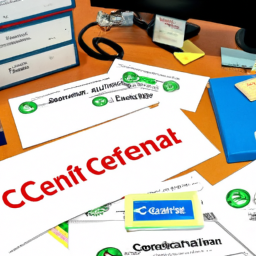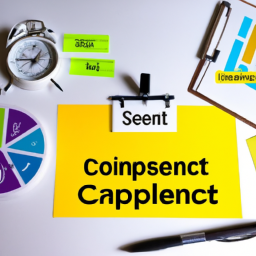Are you an agile enthusiast eager to ace the SCRUM exam? Look no further!
Get ready to dive into the top 10 must-know SCRUM exam topics that will take your agile knowledge to new heights.
From roles and responsibilities to estimation techniques, collaboration to continuous improvement, this article has got you covered.
So buckle up and prepare to become a SCRUM master in no time!
Key Takeaways
- The Scrum Master plays a crucial role in facilitating the Scrum process, removing obstacles, and ensuring the team is functioning effectively.
- Agile principles, such as customer collaboration and delivering working software, are applied in Scrum to achieve improved productivity, flexibility, and team collaboration.
- Scrum events, including Sprint Planning, Daily Scrum, Sprint Review, and Sprint Retrospective, provide opportunities for effective communication, progress tracking, and continuous improvement.
- Estimation, monitoring, and controlling techniques in Scrum, such as story points, burn-down charts, and team velocity, help in accurate project planning, identifying issues, and making data-driven decisions for optimization and adaptation.
Roles and Responsibilities in SCRUM
The scrum master is responsible for facilitating the scrum process and removing any obstacles that the team may encounter. They act as a coach and mentor to the team members, guiding them in applying scrum principles and practices. The scrum master plays a crucial role in ensuring that the team is functioning effectively and efficiently.
Additionally, the scrum master is responsible for organizing and leading the daily scrum meetings, sprint planning, sprint reviews, and retrospectives. They foster a collaborative and productive environment, promoting open communication and transparency within the team.
Overall, the scrum master’s responsibilities revolve around enabling the team to deliver high-quality products and achieve their sprint goals successfully.
SCRUM Framework and Agile Principles
In this discussion, you will learn about the key principles of Agile methodology and how they are applied in SCRUM.
We will explore the core values of Agile, such as customer collaboration, responding to change, and delivering working software.
Additionally, we will delve into the benefits of utilizing SCRUM in your projects, including improved productivity, increased flexibility, and enhanced team collaboration.
Key Agile Principles Explained
Agile principles are essential for successful scrum implementation in projects. Understanding these principles will help you effectively apply the scrum framework.
The first key agile principle is customer collaboration over contract negotiation. This means that instead of focusing solely on strict contracts, prioritize open and constant communication with your customers.
The second principle is responding to change over following a plan. Embrace change and be flexible in your approach to adapt to evolving requirements.
The third principle is working software over comprehensive documentation. Instead of getting caught up in excessive documentation, prioritize delivering a working product to your customers.
The final principle is individuals and interactions over processes and tools. Focus on the people involved in the project and encourage collaboration and communication.
Benefits of SCRUM
To fully understand the benefits of SCRUM, you should consider how it can improve collaboration and productivity within your team. Here are four key benefits of implementing SCRUM:
-
Increased collaboration: SCRUM encourages frequent communication and collaboration among team members, resulting in better transparency and alignment towards project goals.
-
Improved productivity: By breaking down projects into smaller, manageable tasks called sprints, SCRUM helps teams stay focused, prioritize work, and deliver high-quality results within shorter timeframes.
-
Enhanced flexibility: SCRUM allows for adaptability, as it embraces change and encourages teams to continuously refine and adjust their approach based on feedback and evolving requirements.
-
Higher customer satisfaction: With regular review cycles and early delivery of working software, SCRUM enables teams to gather valuable customer feedback, leading to improved customer satisfaction and product success.
While SCRUM offers numerous benefits, it’s important to acknowledge the challenges in implementation, such as resistance to change, lack of experience, and the need for proper training and support. However, with proper planning and commitment, the benefits of SCRUM can significantly outweigh these challenges.
SCRUM Events: Sprint Planning, Daily Scrum, Sprint Review, Sprint Retrospective
The Daily Scrum is a quick stand-up meeting where you and your team members discuss your progress and any obstacles you are facing. It is an important event in Scrum because it helps to keep everyone on the same page and ensures that any issues are addressed in a timely manner.
During the Daily Scrum, you will have the opportunity to share what you have accomplished since the last meeting, what you plan to work on next, and any impediments that may be slowing you down. This meeting should be time-boxed to 15 minutes or less to keep it focused and efficient.
Product Backlog and User Stories
User stories are a valuable tool in agile development for capturing user requirements and ensuring that the product backlog is prioritized effectively. They provide a clear and concise description of user needs, allowing the development team to focus on delivering value.
To effectively manage the product backlog and refine user stories, consider the following:
-
Break down user stories into smaller, manageable tasks to improve estimation accuracy and facilitate progress tracking.
-
Prioritize user stories based on their business value and dependencies to ensure that the most valuable features are delivered first.
-
Continuously refine and groom the product backlog to remove duplicates, clarify requirements, and ensure that it is always up-to-date.
-
Collaborate with stakeholders, including the product owner and development team, to gather feedback and refine user stories as needed.
By effectively managing the product backlog and refining user stories, you can ensure that the development process remains focused and efficient.
Now, let’s explore estimation techniques in scrum.
Estimation Techniques in SCRUM
Try using estimation techniques in SCRUM to accurately plan and forecast project timelines.
One popular technique is using story points, which is a unit of measure representing the effort required to complete a user story. By assigning story points to each user story, you can estimate the time it will take to complete them.
Another technique is planning poker, where team members discuss and estimate the effort required for each user story. This technique encourages collaboration and ensures that everyone’s input is considered. During planning poker, team members use a deck of cards with different numbers representing story points. They take turns revealing their estimates and discussing any discrepancies until a consensus is reached.
Estimation techniques like story points and planning poker can help teams make more accurate project timelines and increase transparency in the development process.
Monitoring and Controlling Progress in SCRUM
To effectively monitor and control progress in SCRUM, you should regularly review the burn-down chart and team velocity. These two tools provide valuable insights into the team’s progress and help identify any potential issues or bottlenecks.
Here are four key points to consider when tracking progress and evaluating performance:
-
Burn-down Chart: This chart visually represents the remaining work and the team’s progress towards completing it. It helps you track the actual progress against the planned work, allowing you to make informed decisions and take appropriate actions.
-
Team Velocity: This metric measures the amount of work the team can complete in a given iteration. By analyzing the team’s velocity over time, you can identify trends and make accurate forecasts for future iterations.
-
Daily Stand-ups: These short, daily meetings provide an opportunity for the team to discuss progress, challenges, and plans for the day. It allows for transparency and helps the team stay on track.
-
Retrospectives: Regular retrospectives enable the team to reflect on their performance and identify areas for improvement. It encourages continuous learning and helps in adapting and refining the process.
Collaboration and Communication in SCRUM
When it comes to team dynamics and synergy in SCRUM, effective communication and collaboration are key. It is important for team members to work together and understand each other’s strengths and weaknesses in order to achieve a harmonious and productive working environment.
Additionally, effective information sharing is crucial for the success of a SCRUM team. It allows for better decision-making, problem-solving, and overall project progress.
Team Dynamics and Synergy
Understanding team dynamics and achieving synergy is crucial for successful implementation of agile methodologies. In order to build an effective team, you need to focus on team building activities and foster a sense of camaraderie among team members.
Conflict resolution is also an essential skill to have, as conflicts can arise in any team setting. By addressing conflicts promptly and finding resolutions that satisfy all parties involved, you can prevent them from escalating and negatively impacting the team’s productivity.
To achieve synergy, it is important to establish clear goals and expectations for the team, promote open and effective communication, and encourage collaboration and cooperation among team members. This will help create a positive and productive team environment where everyone is working towards a common goal.
Effective Information Sharing
Ensure that you actively participate in team meetings and discussions, as effective information sharing is crucial for the success of the project. By actively engaging in these sessions, you contribute to the overall knowledge sharing within the team.
Effective communication plays a vital role in ensuring that everyone is on the same page and has a clear understanding of project goals and objectives. Sharing information in a timely and concise manner helps to avoid misunderstandings and facilitates collaboration among team members. It also enables the team to make informed decisions and take necessary actions.
In addition to attending meetings, make sure to actively listen to others, ask questions, and provide relevant input. Remember, effective information sharing is the key to a successful project.
Agile Metrics and Reporting in SCRUM
To effectively track your team’s progress and performance, you’ll need to use agile metrics and reporting in SCRUM. Agile metrics analysis provides valuable insights into the team’s efficiency and helps identify areas for improvement. Reporting techniques play a crucial role in communicating the team’s progress to stakeholders and ensuring transparency.
Here are four key points to consider when using agile metrics and reporting in SCRUM:
-
Define meaningful metrics: Choose metrics that align with your team’s goals and objectives. Focus on metrics that measure productivity, quality, and customer satisfaction.
-
Use visual dashboards: Visualize your metrics using dashboards that provide a clear and concise overview of your team’s performance. This allows for easy interpretation and analysis of the data.
-
Regularly review and analyze metrics: Continuously monitor and analyze your metrics to identify trends and patterns. This will help you make data-driven decisions and take corrective actions when necessary.
-
Foster a culture of transparency: Share your metrics and reports with all stakeholders to create a transparent and collaborative environment. This encourages accountability and facilitates better decision-making.
Continuous Improvement and Adaptation in SCRUM
Make sure you regularly reflect on your team’s performance and identify areas for improvement in order to foster continuous improvement and adaptation in SCRUM. By implementing continuous improvement techniques and adaptive planning strategies, you can enhance your team’s productivity and deliver better results. One effective way to track and analyze your team’s performance is by using metrics and reporting. This allows you to identify bottlenecks, inefficiencies, and areas of improvement. Additionally, conducting regular retrospectives can help your team reflect on their processes and identify ways to optimize and adapt. By continuously improving and adapting, you can ensure that your team is always striving for excellence and delivering value to your stakeholders. The table below provides an overview of some continuous improvement techniques and adaptive planning strategies that you can leverage in SCRUM:
| Continuous Improvement Techniques | Adaptive Planning Strategies |
|---|---|
| Retrospectives | Iterative Planning |
| Kaizen | Rolling Wave Planning |
| Value Stream Mapping | Capacity Planning |
| Lean Principles | Real-Time Adjustments |
Challenges and Best Practices in Agile Implementations
In this discussion, you will explore the challenges and best practices in implementing agile methodologies.
You will delve into the key points of scaling agile teams, change management strategies, and measuring project success.
Scaling Agile Teams
Scaling Agile Teams can be a complex process, but it is essential for organizations looking to maximize their efficiency and productivity. As you navigate through the challenges of scaling, keep in mind these key points:
-
Communication: Maintaining clear and effective communication is crucial when scaling Agile Teams. Ensure that all team members are aligned on goals, priorities, and progress.
-
Coordination: As the size of the team grows, coordination becomes more challenging. Implement tools and processes that facilitate coordination and collaboration between team members.
-
Leadership: Scaling Agile Teams requires strong leadership. Leaders must provide guidance, support, and empowerment to the team members, fostering a culture of trust and accountability.
-
Flexibility: Agile transformation is an ongoing journey, and scaling requires flexibility. Be open to adapting and evolving your approach as the needs of the team and organization change.
Change Management Strategies
As you navigate through the process of scaling Agile teams, it’s important to implement effective change management strategies to successfully transition the organization and its members to the new way of working. Change resistance is a common challenge when introducing Agile practices, but by engaging stakeholders throughout the process, you can address their concerns and ensure their buy-in. Here is a table that highlights the key strategies for managing change in Agile:
| Change Management Strategies |
|---|
| Communicate the vision and benefits of Agile to stakeholders |
| Involve stakeholders in the decision-making process |
| Provide training and support to help people adapt to Agile |
| Celebrate small wins and recognize the efforts of team members |
Measuring Project Success?
Measuring project success is crucial for evaluating the effectiveness of Agile adoption and ensuring that the organization is achieving its goals. To effectively evaluate project success, consider the following factors:
-
Clear objectives: Clearly defined project objectives help determine whether the project is on track and meeting its intended outcomes.
-
Deliverables: Assessing whether project deliverables are being completed on time and within budget is essential for measuring success.
-
Stakeholder satisfaction: Evaluating stakeholder satisfaction helps gauge whether the project is meeting their expectations and needs.
-
Key performance indicators (KPIs): Defining and tracking KPIs allows for the measurement of project performance against specific, measurable goals.
Frequently Asked Questions
What Are the Key Challenges Faced by Organizations When Implementing Agile Methodologies?
When implementing agile methodologies, organizations face key challenges such as change management and agile transformation. These challenges arise due to the need to shift from traditional project management approaches to a more collaborative and adaptive mindset.
Change management involves addressing resistance to change, ensuring stakeholder buy-in, and managing the cultural shift within the organization. Agile transformation requires aligning teams, implementing agile practices, and fostering a culture of continuous improvement.
Overcoming these challenges is crucial for successful agile implementation.
How Can Agile Metrics Be Used to Track and Report on Project Progress?
To effectively track and report on project progress, you can utilize agile metrics. These metrics provide valuable insights into the performance of your agile projects.
By measuring key indicators such as sprint velocity, burn-up and burn-down charts, and cycle time, you can assess the progress and identify any potential bottlenecks or areas for improvement.
Agile metrics also help in providing accurate and transparent reports to stakeholders, enabling them to make informed decisions based on the project’s current status.
What Are Some Best Practices for Effective Collaboration and Communication Within Agile Teams?
To ensure effective collaboration and communication within agile teams, it’s important to implement certain best practices.
Start by establishing clear goals and objectives for the team.
Encourage open and transparent communication, fostering an environment where everyone feels comfortable sharing their thoughts and ideas.
Utilize effective collaboration techniques such as daily stand-up meetings, where team members can discuss progress, challenges, and plans.
Implement communication strategies like using project management tools and conducting regular team retrospectives to continuously improve collaboration and communication.
How Can Agile Principles Be Applied in Industries Outside of Software Development?
Agile principles can be as versatile as a Swiss Army knife. They can be applied in industries outside of software development, like manufacturing and marketing campaigns.
In manufacturing, Agile applications can optimize processes, increase productivity, and adapt quickly to changing demands.
In marketing campaigns, Agile methodologies can ensure flexibility, collaboration, and quick response to customer feedback.
What Are Some Common Estimation Techniques Used in Agile Project Management?
In agile project management, there are several common estimation techniques that you should be familiar with.
One technique is planning poker, where team members use a deck of cards to estimate the effort required for each user story.
Another technique is affinity estimation, where team members group similar user stories together based on their complexity.
These estimation techniques help teams in agile projects to make accurate and informed decisions about the effort required for each task.
Conclusion
So there you have it – the top 10 must-know topics for the SCRUM exam. By understanding these key concepts, you will be well-equipped to navigate the world of Agile and SCRUM.
One interesting statistic to highlight is that according to a survey conducted by Scrum.org, organizations that fully embrace Agile practices are 28% more successful than those that don’t. This statistic emphasizes the importance of implementing SCRUM and Agile principles in order to achieve success in today’s fast-paced and ever-changing business landscape.
Good luck on your SCRUM journey!




















